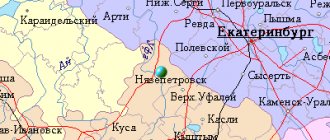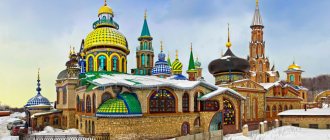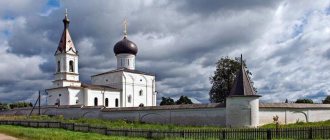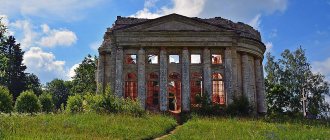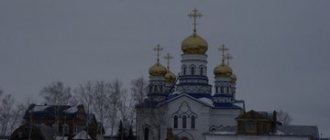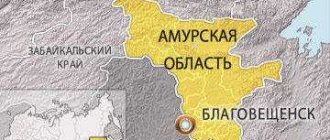Rzhev
(Tver region)
OKATO code:
28445
Founded:
1216
City since:
1216 City of regional subordination
Center:
Rzhevsky district
Telephone code (reference phone)
| 48232***** | 20-02-3 |
Deviation from Moscow time, hours:
0
Geographic latitude:
56°15′
Geographic longitude:
34°20′
Altitude above sea level, meters:
190 Sunrise and sunset times in the city of Rzhev
Where do residents of the Tver region live?
The Tver region and Tver are located on a flat territory; the region is practically devoid of mineral resources. Coal mining stopped here a few years ago, but there are large deposits of peat. The main river is the Volga, and many tributaries flow here and several reservoirs have been created - Rybinskoye, Verkhnevolzhskoye, Ivankovskoye and Uglichskoye. It is in the Tver region that the today famous Lake Seliger is located - a place for political meetings of young people and the country's top leadership.
The area of the Tver region is slightly more than 82 thousand square meters. km, is considered the 38th largest in area among Russian regions. Most of the territory is occupied by broad-leaved, mixed and coniferous forests, rich in flora and fauna. The vast Orsha swamp is also located here. Until recently, peat extraction work was carried out here. Development is currently underway, but at a slower pace due to poor demand for this resource.
Map
| Rzhev: maps |
Rzhev: photo from space (Google Maps) Rzhev: photo from space (Microsoft Virtual Earth)
| Rzhev. Nearest cities. Distances in km. on the map (in brackets along roads) + direction. Using the hyperlink in the distance , you can get the route (information courtesy of the AutoTransInfo website) | |||
| 1 | Zubtsov | 18 (23) | SE |
| 2 | Sychevka | 46 (68) | YU |
| 3 | oxbow | 47 (49) | NE |
| 4 | Olenino | 52 (58) | Z |
| 5 | Novodugino (Smolensk region) | 68 (95) | YU |
| 6 | Shakhovskaya (Moscow region) | 77 (87) | IN |
| 7 | Lotoshino (Moscow region) | 81 (113) | IN |
| 8 | Selizharovo | 85 (98) | NW |
| 9 | Kuvshinovo | 87 (221) | WITH |
| 10 | Gagarin | 88 (157) | SE |
| 11 | Nelidovo | 95 (104) | Z |
| 12 | Torzhok | 95 (122) | NE |
| 13 | Kholm-Zhirkovsky (Smolensk region) | 97 (144) | SW |
| 14 | White | 98 (152) | SW |
| 15 | Volokolamsk | 103 (118) | IN |
| 16 | Vyazma | 116 (139) | YU |
| 17 | Tver | 117 (121) | NE |
| 18 | Likhoslavl | 118 (163) | NE |
a brief description of
Located on the southeastern outskirts of the Valdai Upland, on the high bank of the Volga River, 130 km southwest of Tver. Railway junction lines.
Territory (sq. km): 56
Information about the city of Rzhev on the Russian Wikipedia site
Historical sketch
It was first mentioned in 1216 as Rzhev, the possession of the Toropets prince Mstislav the Udal. The basis of the oikonym is most often seen as the nickname Rzha or the hydronym Rzha (Rzhava, Rzhavets), usually referring to springs with ferruginous water of a brown (rusty) color, to rusty swamps. It is also possible to form it with the suffix -ev from the Old Russian ryzh “rye, rye field.”
From the 13th century as part of the Smolensk Principality, at the end of the 13th - beginning of the 14th centuries. the center of the Rzhev Principality, later - under the rule of the Smolensk princes.
In the 14th - 15th centuries. the city was the object of the struggle of the Smolensk Principality, the Grand Duchy of Lithuania, the Moscow and Tver Grand Duchies. From 1449 it finally became part of the Moscow Grand Duchy.
In 1581, Rzhev was besieged by the Polish troops of Stefan Batory.
At the beginning of the 18th century. After the construction of the Vyshnevolotsk water system, Rzhev became a major transshipment point on the waterway to St. Petersburg.
In 1708, Rzheva Volodimerova was assigned to the Ingermanland province (from 1710 - St. Petersburg), from 1719 - to the Tver province. From 1727 - in the Novgorod province. Since 1775, the district city of the Tver governorship (since 1796 - Tver province).
In the 18th century one of the centers of the schismatic movement in the Upper Volga region.
In 1856, in the district city of Rzhev, Tver province, there were 10 churches, 2605 houses, 237 shops.
In 1847, the Vyazma-Likhoslavl railway passed through the city, in the 1890s. - Vindava - Moscow railway. Rzhev became a major center of flax trade (hemp processing, production of hemp yarn and rope).
Since 1929 - the center of the district in the Western region. In 1935-90. regional center of the Kalinin (since 1990 Tver) region.
During the Great Patriotic War of 1941-45, it was occupied by Nazi troops on October 14, 1941. From the beginning of 1942, fierce fighting took place in the vicinity of Rzhev, which was of great strategic importance on the approaches to Moscow, as a result of which Rzhev was severely destroyed. Less than 10% of the building survived. The city was liberated on March 3, 1943 by troops of the Western Front during the Rzhev-Vyazemsk operation.
Municipal indicators
| Index | 2001 |
| Demography | |
| Number of births, per 1000 population | 6.9 |
| Number of deaths, per 1000 population | 21.2 |
| Natural increase (decrease), per 1000 population | -14.3 |
| Standard of living of the population and social sphere | |
| Average monthly nominal accrued wages, rub. | 2324 |
| Average housing area per inhabitant (at the end of the year), sq.m. | 20.1 |
| Number of preschool institutions, pcs. | 24 |
| Number of children in preschool institutions, thousand people | 2.2 |
| Number of daytime educational institutions (at the beginning of the school year), pcs. | 14 |
| Number of students in daytime educational institutions, thousand people | 7.7 |
| Number of doctors, people. | 276 |
| Number of nursing staff, people. | 904 |
| Number of hospital institutions, pcs. | 5 |
| Number of hospital beds, thousand units | 0.9 |
| Number of medical outpatient clinics, pcs. | 9 |
| Capacity of medical outpatient clinics, visits per shift, thousand units. | 1.3 |
| Number of registered crimes, pcs. | 1409 |
| Persons who committed crimes were identified, persons. | 867 |
| Economy, industry | |
| Number of enterprises and organizations (at the end of the year), pcs. | 1869 |
| Construction | |
| Volume of work performed by type of activity “Construction” (until 2004 - volume of work performed under construction contracts), million rubles. | 162.2 |
| Commissioning of residential buildings, thousand sq.m. of total area | 1.5 |
| Commissioning of residential buildings, apartments | 11 |
| Commissioning of preschool institutions, places | 0 |
| Commissioning of educational institutions, places | 300 |
| Commissioning of hospital facilities, beds | 0 |
| Commissioning of outpatient clinics, visits per shift | 0 |
| Transport | |
| Number of bus routes (in intracity traffic), pcs. | 6 |
| Number of passengers transported by buses per year (in intracity traffic), million people. | 14.6 |
| Connection | |
| Number of residential telephone sets of the city public telephone network, thousand units. | 6.8 |
| Trade and services to the population | |
| Retail trade turnover (in actual prices), million rubles. | 395.3 |
| Retail trade turnover (in actual prices), per capita, rub. | 4762 |
| Public catering turnover (in actual prices), million rubles. | 17 |
| Volume of paid services to the population (in actual prices), million rubles. | 150.9 |
| Volume of paid services to the population (in actual prices), per capita, rub. | 1832 |
| Volume of household services to the population (in actual prices), million rubles. | 16.7 |
| Volume of household services to the population (in actual prices), per capita, rub. | 203 |
| Investments | |
| Investments in fixed assets (in actual prices), million rubles. | 147.5 |
| Share of investments in fixed assets financed from budgetary funds in the total volume of investments, % | 45.2 |
Data sources:
- Regions of Russia. Main characteristics of the constituent entities of the Russian Federation: statistical collection. Goskomstat of Russia. - M:, 2003.
Economy
Mechanical engineering, flax processing and food industries are most developed in Rzhev.
PA "Rzhevbashkran" Factories: automotive and tractor electrical equipment, drainage pipes. Factories: furniture, non-metallic materials (including the production of dolomite flour), jacquard weaving. Flax carding factory, etc.
In the Rzhev region: dairy and beef cattle breeding, sheep breeding (Romanov breed), poultry farming. They grow flax and potatoes.
Main enterprises
MECHANICAL ENGINEERING
JSC "Eltra"
172350, Tver region, Rzhev, Zubtsovskoe highway, 42
Offers:
electrical equipment for automobiles and tractors, spare parts for cars
JSC "Vysota"
172350, Tver region, Rzhev, st.
Kranostroiteley, 32 Offers:
tower cranes, electric motors, point cranes
Culture, science, education
Museums: local history, Great Patriotic War.
Universities of the city
Moscow Social and Humanitarian Institute (Rzhev branch)
172381, Tver region, Rzhev, Partizanskaya st., 26/15 WWW: https://www.msgi-rz.edu.ru/
Tver State Technical University (Rzhev branch)
172390, Tver region, Rzhev, st. Lenina, 5
Tver State University (Rzhev branch)
172386, Tver region, Rzhev, Zavodskoe highway, 14
Museums, galleries, exhibition halls
Rzhev Museum of Local Lore 172381, Tver region, Rzhev, st. Krasnoarmeyskaya embankment, 26, 24-a Website: https://tvermuzeum.ru/
Architecture, sights
Churches: John the Baptist (1818, bell tower 1841), Voznesenskaya (1855), Smolenskaya (1861). Residential buildings of the 18th - 19th centuries.
| Population by year (thousands of inhabitants) | |||||||
| 1856 | 13.6 | 1973 | 65 | 2001 | 68.4 | 2014 | 60.8 |
| 1897 | 21.3 | 1976 | 67 | 2003 | 63.7 | 2015 | 60.3 |
| 1913 | 23.2 | 1979 | 68.9 | 2005 | 62.4 | 2016 | 60.0 |
| 1926 | 33 | 1982 | 70 | 2006 | 61.6 | 2017 | 59.8 |
| 1931 | 34.0 | 1986 | 70 | 2007 | 61.0 | 2018 | 59.4 |
| 1939 | 54.1 | 1989 | 69.8 | 2008 | 60.7 | 2019 | 58.6 |
| 1959 | 49.0 | 1992 | 70.9 | 2010 | 60.1 | 2020 | 57.5 |
| 1962 | 55 | 1996 | 70.4 | 2011 | 62.0 | 2021 | 56.4 |
| 1967 | 59 | 1998 | 70.2 | 2012 | 61.4 | ||
| 1970 | 60.7 | 2000 | 69.0 | 2013 | 61.1 | ||
Population
The main city of the region has a rich and glorious history. The city is located in a picturesque location, located on both sides of the Volga River. Today, the population of Tver exceeds 400 thousand. The city stands on the Upper Volga Plain, with only low hills and elevations.
The Volga has always been of great importance in the history of Tver. Merchants rafted along the river, transporting timber and other goods directly to Moscow. The widest point of the river within the city is 552 meters. The first mention of a rural settlement in these parts dates back to the 11th century. In the 13th century, the first city was completely destroyed by the Tatars, but was quickly rebuilt. There is a version that after the devastation on the left bank, the population of Tver moved to the right side of the Volga and built a new settlement here.
At the end of the 15th century, Tver became an important trade and cultural center. Here are the routes of communication between Novgorod and Vladimir. In addition, it was in Tver that unique monuments of ancient Russian literature were created: “The Tale of Mikhail Alexandrovich”, “A Word of Praise to the Tver Prince Boris Alexandrovich”. The city has preserved many churches, the Kremlin with examples of traditional Russian architecture.
Today, 419 thousand people live in Tver, a fairly high figure; over the past decades, there has been no sharp departure of residents to other regions. The highest numbers were recorded in the late 90s, when over 450 thousand people lived in the city.
Attractions
The cities of the Tver region are famous for their ancient history. Extensive archaeological excavations are carried out here every year. The oldest of the settlements, Torzhok, dates back to the end of the 10th century. Until now, monuments from the 13th and 14th centuries have been preserved here in their original form, for example, the Borisoglebsky and Resurrection monasteries. They are still in effect today.
One of the best attractions of the region is its nature, rich forests, the Volga, Lake Seliger and other large reservoirs. Tourism is developed quite well, there are more than 200 tourist accommodation sites in the region, the regional government is trying to create favorable conditions for both Russian and foreign tourists.
People are attracted by ancient architecture, unique museums of folk art or local history. In addition, thousands of pilgrims come here every year to visit monasteries and temples sacred to Christians. One of the wonders of the Tver region is Lake Seliger. Every year international meetings are held here, in addition, tourists come here just to relax and enjoy the unique nature.
Black swamp
The Black or Rzhev swamp was located here back in the 19th century. It got its name because of cases of disappearances of people. Currently, the reservoir has already dried up, and houses stand in its place, but anomalous phenomena continue to appear. Some local residents claim to have seen a UFO over the former swamp.
Scientists - geologists say that all the anomalies are easy to explain - in the ground where the swamp was, specific gases are formed that come out. If you inhale them, a person may experience hallucinations, visions or illness.
The swamp is located in the southern part of Rzhev. It originates at the intersection of Vokzalnaya and Dzerzhinsky streets.
House of the Obraztsov merchants
The house of the Obraztsov merchants is a two-story mansion in which the famous merchant V.M. lived. Samples. This building is an architectural monument, it is made in the style of early classicism.
Obraztsov became famous for the fact that it was he who had the honor of meeting Alexander I in the 20s of the 19th century. At that time, the ruler was on his way from Belsk; along the way he stopped with several townspeople, and after that he lived with Obraztsov.
In 1875, a theater was created in a merchant's house. Subsequently, the merchant's descendants continued his business and opened a paper and paper production. The house now houses a police station.
House of the Obraztsov merchants
Address: Rzhev, Sovetskaya Square.
Rzhev Memorial Complex
The memorial complex consists of several objects created at different times:
- German military cemetery;
- Red Army cemetery of fallen soldiers;
- memorial to Kazakhstani soldiers;
- a pedestal of memory and a small chapel of Alexander Nevsky;
- statue "To Grieving Parents";
- a monument dedicated to the memory of the dead Jewish prisoners.
Most of the military personnel who died during the Battle of Rzhev were buried in these mass graves. Soldiers and officers from Germany sometimes come to the German cemetery.
Rzhev Memorial Complex
The Rzhev Memorial is located on the outskirts of the village - in the area of Ostashkovskoye Highway.
Rzhev temples
The history of Rzhev was turbulent. Enemy raids brought grief and destruction. Therefore, there are not many ancient temples here. But in the modern period, religious buildings were actively built. Therefore, admirers of temple architecture have something to see in Rzhev.
Cathedral of the Ascension of Christ
The Ascension Cathedral was once part of a large temple complex. The five-domed church enjoyed special veneration among parishioners, because the miraculous image of the Mother of God of Kazan was kept within its walls. The sacrilege of the Bolsheviks and the war turned the temple into ruins. The Orthodox relic was lost. The revival of the church began at the end of the last century. The rite of re-consecration of the cathedral took place in 1987. Today, the white stone building with high light drums of the domes looks wonderful.
Temple of Russian Confessors and New Martyrs
The colorful five-domed temple appeared in the city in 2004 and immediately joined the number of iconic sights of Rzhev. The cross of the main hipped dome of the church overshadows the polis from a 35-meter height. The bells for the belfry were cast in the Urals. The largest of them weighs 1.6 tons. The building, built on the model of ancient Moscow red brick churches, looks magnificent. The bell tower's light drum and faceted domes look especially elegant.
Intercession Church
Not many Old Believer churches have survived in Central Russia. One of them is located in Rzhev. The rite of consecration of the Intercession took place in 1910. The appearance of the brick church corresponds to the Old Russian canons. The main tent dome covers the traditional octagon, around which domes with miniature onions are erected. The interior of the temple is ascetic. Its only decoration is the iconostasis with images painted at the beginning of the 19th century.
Pastime of the population
There are many monuments of historical and cultural heritage in Tver and the region. There are especially many preserved monasteries and temples, some of which are more than 500 years old. The Ascension Cathedral in Tver was built in the mid-18th century and today has the status of a bishop's courtyard. The church burned more than once and was rebuilt; today the relics of the holy martyr Thaddeus are kept here.
A real work of art is the Staritsky Holy Dormition Monastery, which is located in a picturesque location on the banks of the Volga. The monastery was founded in the 12th century, but the first buildings have not survived to this day and were destroyed in the 14th century. Almost a hundred years later, the monastery was rebuilt from scratch; it is these white stone buildings that have survived today.
The unique temple is located in the city of Torzhok; the wooden building, built in the 18th century, has stood with minimal restoration for more than 200 years. Even a painting from the mid-18th century has been preserved in almost intact condition.
Crime
The cities of the Tver region have been in crime news more than once. Back in the early 90s, as throughout the country, bandits or “new Russians” operated here. Among all, the Tver Wolves gang stood out, committing murders in the region for several years. The leader of the gang, Alexander Kostenko, or Lom, already in the late 90s took over almost the entire shadow business of Tver. The group, in addition to fighters and killers, included corrupt officials, well-versed lawyers and some security officials.
The manner in which the Tver Wolves conducted business kept the entire population of the cities of the Tver region in fear. From obedient and faithful people, Lom put together a brigade of terrorist killers, they did not spare anyone and acted on the principle “the more victims, the better.”
They killed their enemies en masse, for everyone to see, to demonstrate their power and avoid any disobedience. One of their bloodiest crimes was the massacre of the market director’s family; the killers spared no one, not the director’s wife, nor his two minor children. It is this gang that is suspected of murdering the famous singer Mikhail Krug.
One of the latest high-profile cases is the murder of 9 people in the Tver region. The tragedy occurred in June 2021, when in a friendly cooperative Sergei Egorov without regret dealt with 9 people, sparing no one, not even an old disabled woman. This story thundered throughout the country; Yegorov himself practically did not give interviews, once telling reporters that he killed people because they laughed at him. In the fall, Egorov was sentenced to life imprisonment.
Places of work of the population
The population of the Tver region is mainly employed in the manufacturing industry: the production of furniture, building materials, textiles and leather goods. In addition, the region has developed the production of equipment for Russian Railways: passenger cars, electric trains, excavators, etc. The production and distribution of electrical energy reserves brings large income to the regional treasury. The Kalinin NPP and Konakovskaya GRES provide electricity to several neighboring regions.
The local lands are rich in peat deposits, which is why the largest peat mining company in Russia operates here. Even 20 years ago, coal was actively mined here, but the surface deposits have dried up, and developing new ones is unprofitable and expensive.
In the field of transport, the Tver region is in a very advantageous position. There are two highways, 4 railway lines, and two civil airports operating near Tver with daily domestic and international flights.
Agricultural output has fallen by half since 1990, but is still gradually returning to strength. The fields are sown with flax, wheat and vegetables.
Staritsa catacombs
Catacombs are caves about 32 km long, created in the 13th century. They appeared as a result of the extraction of white stone, which was actively used for the construction of temples and other structures. The material was mined until the twentieth century.
You can visit Terrasnaya, Verkhnechukavinsky, Srednetolpinsky, and Nizhnetolpinsky emptiness.
Staritsa catacombs are known for their paranormal phenomena. Many people say that if they drop something in caves, it will be impossible to find this object. Local guides say that this is due to the mass death of the villagers, which was located on this site long before the appearance of the quarry.
Staritsa catacombs
The entrance to the caves is located on the Volga coast, 12 km from the village of Tolpino.
Important! To visit the catacombs, you must find a guide. Visiting the caves on your own is dangerous.
